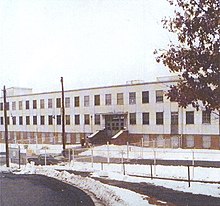Arlington Hall

Arlington Hall (also called Arlington Hall Station) is a historic building in
History

Arlington Hall was founded in 1927 as a private
During World War II, Arlington Hall was in many respects similar to
The Arlington Hall effort was comparable in influence to other Anglo-American
After World War II, the "Russian Section" at Arlington Hall expanded. Work on diplomatic messages benefited from additional technical personnel and new analysts—among them Samuel Chew, who had focused on Japan, and linguist Meredith Gardner, who had worked on both German and Japanese messages. Chew had considerable success at defining the underlying structure of the coded Russian texts. Gardner and his colleagues began analytically reconstructing the KGB (Soviet Union's Committee for State Security) spy agency codebooks. Late in 1946, Gardner broke the codebook's "spell table" for encoding English letters. With the solution of this spell table, SIS could read significant portions of messages that included English names and phrases. Gardner soon found himself reading a 1944 message listing prominent atomic scientists, including several with the Manhattan Project. Efforts to decipher Soviet codes continued under the classified and caveated Venona project.
Another problem soon arose—that of determining how and to whom to disseminate the extraordinary information Gardner was developing. SIS's reporting procedures did not seem appropriate because the decrypted messages could not even be paraphrased for Arlington Hall's regular intelligence customers without divulging their source. By 1946, SIS knew nothing about the federal grand jury impaneled in Manhattan to probe the espionage and disloyalty charges stemming from
By 1945, the Soviets had penetrated Arlington Hall with the placement of Bill Weisband who worked there for several years. The Government's knowledge of his treason apparently was not revealed until its publication in a 1990 book co-authored by a high-level KGB defector.
Arlington Hall came under the aegis of the
Arlington Hall was also home in the late 1950s and early 1960s to the
In 1989, the

In January 2008, construction workers discovered an unexploded
Current uses
The
See also
References
- ^ Official site of Arlington County, Virginia Text-Site: Our Back Pages: Stories, Scenes and Events From Arlington's Past Accessed January 11, 2009
- ^ On The Trail of Military Intelligence History: A Guide to the Washington, DC, Area: Arlington Hall: From Coeds to Codewords' prepared by the United States Army Intelligence and Security Command History Office, pp. 16–17 Accessed January 17, 2008
- ^ Budiansky 2000, pp. 320–325.
- ^ Defense Intelligence Agency's Text-Site: DIA History Archived May 14, 2011, at the Wayback Machine Accessed January 11
- ^ On The Trail of Military Intelligence History, p. 17 Accessed January 17, 2008
- ^ US Army Intelligence and Security Command's (INSCOM) Text-Site: INSCOM History, by the INSCOM History Office Accessed January 17, 2008
- ^ Honley, S.A., Focus on FSI/FS Training: FSI Settles into Arlington Hall, Foreign Service Journal, July-August 2005 Archived July 12, 2007, at the Wayback Machine Accessed January 17, 2008
- ^ Secretary of State Colin L. Powell: Remarks at the Ceremony Renaming the National Foreign Affairs Training Center to the George P. Shultz National Foreign Affairs Training Center, Arlington, Virginia, May 29, 2002 Archived September 9, 2006, at the Wayback Machine Accessed January 17, 2008
- ^ David, Schultz (February 12, 2008). "Civil War Munitions Found". The Connection. Archived from the original on February 19, 2008. Retrieved February 15, 2008.
- ^ Virginia Department of Historic Resources list of properties on Virginia Landmarks Register and National Register of Historic Places Archived 2017-06-27 at the Wayback Machine Accessed January 18, 2008
Further reading
- Christopher Andrew and Oleg Gordievsky, KGB: The Inside Story (New York: HarperCollins, 1990), 373- 74.
- Budiansky, Stephen (2000). Battle of Wits: The complete story of Codebreaking in World War II. New York: Free Press. ISBN 0-684-85932-7.
- Mundy, Liza (2017). Code Girls. New York: Hachette. ISBN 978-0-316-35253-6.
External links
- NSA - Introductory History of VENONA
- Moynihan Commission Report on Government Secrecy, Appendix A, The Cold War (1997)
- Arlington Hall Station, 4000 Arlington Boulevard, Arlington, Arlington County, VA at the Historic American Buildings Survey(HABS)
- Arlington Hall Station, Main Building, 4000 Arlington Boulevard, Arlington, Arlington County, VA at HABS
- Virginia Living, Social Graces and Espionage
